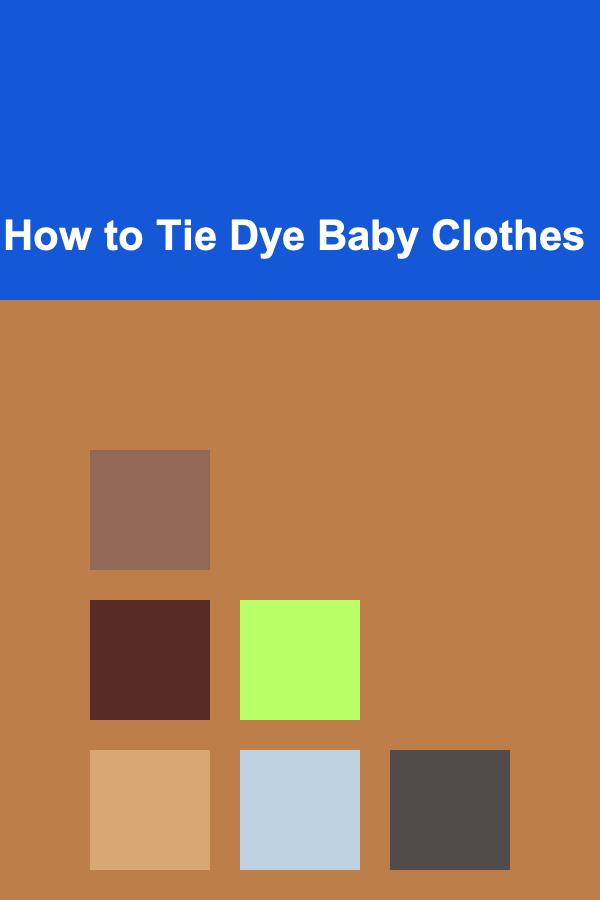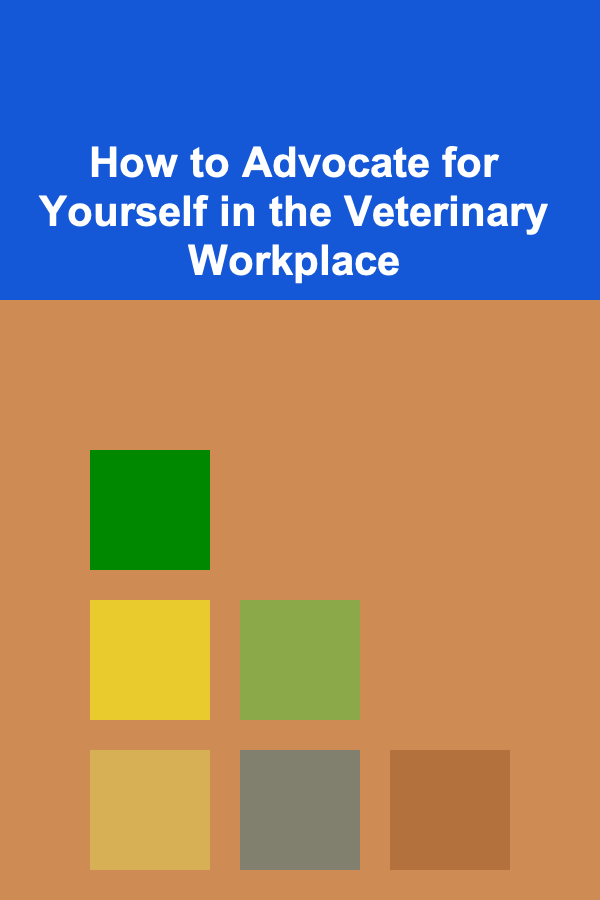
How to Tie Dye Baby Clothes
ebook include PDF & Audio bundle (Micro Guide)
$12.99$8.99
Limited Time Offer! Order within the next:

Tie-dyeing is a fun and creative way to personalize baby clothes, making them unique, colorful, and full of personality. Whether you want to make a special gift, add a personal touch to your baby's wardrobe, or simply enjoy a craft project, tie-dyeing is a fantastic option. This guide will walk you through everything you need to know to tie-dye baby clothes, from choosing the right materials to creating beautiful designs.
1. Why Tie-Dye Baby Clothes?
Before diving into the process, let's explore why tie-dyeing baby clothes is a great idea.
- Unique and Personal: Each tie-dye piece is one-of-a-kind. You can choose colors that match your baby's room, create personalized designs, or use colors that represent your baby's personality.
- Fun Crafting Project: Tie-dyeing is a wonderful hands-on activity that is enjoyable for all ages. It's a great way to unwind while also creating something beautiful for your baby.
- Eco-Friendly: By reusing old plain baby clothes or opting for organic fabrics, you are making an eco-conscious choice. You can turn worn-out or basic clothes into something vibrant and new.
- Gift Idea: Hand-dyed clothes can make amazing and thoughtful gifts for new parents, baby showers, or birthdays.
2. Materials Needed for Tie-Dyeing Baby Clothes
To get started with tie-dyeing, you'll need a few basic materials. Here's a list of what you'll need:
- Baby Clothes: You can tie-dye any baby garment such as onesies, t-shirts, rompers, socks, or even bibs. Natural fabrics like cotton work best for tie-dyeing as they absorb the dye better.
- Fabric Dye: Choose a fabric dye that is safe for babies. Many fabric dye brands offer non-toxic and baby-safe dyes. Popular brands include Tulip, Rit, and Dylon. For baby clothes, go for dyes that are machine washable and free from harmful chemicals.
- Rubber Bands: Rubber bands are used to bind and twist the fabric into various shapes, creating the tie-dye effect. The tighter the rubber band, the more defined your design will be.
- Plastic Squeeze Bottles or Spray Bottles: These are used to apply the dye onto the clothes in specific patterns. You can either use squeeze bottles for precision or spray bottles for a more abstract effect.
- Plastic Bags or Plastic Wrap: After applying the dye, you will need to wrap your baby clothes in plastic to allow the dye to set.
- Gloves: Fabric dye can stain your hands, so make sure to wear gloves to protect your skin.
- Plastic Tablecloth or Old Newspapers: To protect your work surface from the dye, lay down a plastic tablecloth or newspapers.
- Water and Mild Detergent: After the dyeing process, you'll need to rinse the clothes in water and wash them with mild detergent to set the color.
3. How to Prepare Baby Clothes for Tie-Dye
Before applying the dye, you must properly prepare the clothes. This ensures that the dye will adhere to the fabric evenly and produce vibrant, long-lasting results.
- Pre-Wash the Clothes: Wash the baby clothes in warm water without any fabric softeners. This will remove any dirt, oils, or residues that could prevent the dye from absorbing properly. Let the clothes dry completely before starting the dyeing process.
- Soak the Clothes: Soak the clean clothes in water mixed with a small amount of soda ash for at least 20 minutes. Soda ash helps the dye bond better with the fabric. After soaking, wring out excess water but keep the clothes damp. If you prefer a more subdued color, you can skip the soda ash.
4. Tie-Dyeing Techniques for Baby Clothes
Tie-dyeing involves several different techniques, each producing different patterns. Below are some popular tie-dye methods you can try:
1. Spiral Design
The spiral design is one of the most classic and recognizable tie-dye patterns. Here's how to create it:
- Lay the damp baby clothes flat on your work surface.
- Pinch the center of the fabric with your fingers and begin twisting the fabric tightly into a spiral shape.
- Secure the spiral with several rubber bands. The more rubber bands you use, the more defined your spiral will be.
- Using your squeeze bottles, apply dye to different sections of the spiral. You can use multiple colors to create a rainbow effect or stick to a single color for a more subtle design.
2. Bullseye Pattern
The bullseye pattern is perfect for creating concentric circles of color.
- Lay the damp baby clothes flat and pinch the fabric in the center.
- Pull the fabric upward and secure it with rubber bands at equal intervals, creating sections.
- Apply dye to each section using different colors. Start with the center and work outward, applying each color in its designated section.
3. Stripes or Zipper Design
For a more geometric design, try creating stripes or a zipper effect:
- Lay the clothes flat and fold them accordion-style or in a zigzag pattern.
- Secure the folded sections with rubber bands.
- Apply dye to each section, alternating colors to create stripes.
4. Shibori-Inspired Folding
For a more traditional Japanese tie-dye effect, you can try Shibori folding techniques. This method involves folding, twisting, or binding the fabric in a specific way to create beautiful, intricate patterns.
- Fold the clothes into various shapes, such as accordion pleats or triangles.
- Bind sections of the fabric with string or rubber bands.
- Apply the dye to different sections, varying the colors for a unique, Shibori-inspired design.
5. Heart Design
For a cute and charming look, you can create a heart-shaped design:
- Lay the baby clothes flat and pinch the center of the fabric.
- Fold the fabric in half to form a triangle.
- Twist the fabric into a heart shape and secure it with rubber bands.
- Apply dye to the sections of the heart, using soft pastel colors for a gentle, baby-friendly look.
5. Setting the Dye
Once you've applied the dye, it's time to let it set. This step is crucial for ensuring vibrant, long-lasting results.
- Wrap the Clothes: After dyeing the clothes, wrap them in plastic bags or plastic wrap. This helps retain heat and moisture, which allows the dye to fully bond with the fabric.
- Wait for the Dye to Set: Let the clothes sit for 6-8 hours or overnight for the best results. The longer the dye sits, the more intense the colors will be.
6. Rinsing and Washing Baby Clothes
Once the dye has set, it's time to rinse and wash the baby clothes.
- Rinse the Clothes: Put on your gloves and rinse the clothes under cold water until the water runs clear. This removes any excess dye.
- Wash the Clothes: Wash the clothes in warm water with a mild detergent to remove any remaining dye. You can wash them separately for the first few washes to avoid dye transfer to other clothing.
7. Caring for Tie-Dyed Baby Clothes
To maintain the vibrant colors of your tie-dyed baby clothes, follow these care instructions:
- Wash Separately: For the first few washes, it's a good idea to wash the tie-dyed clothes separately to avoid color bleeding onto other garments.
- Gentle Cycle: Always wash the clothes on a gentle cycle with mild detergent to preserve the fabric and color.
- Avoid Fabric Softeners: Fabric softeners can cause the dye to fade more quickly, so avoid using them on tie-dyed clothes.
8. Safety Considerations
When tie-dyeing baby clothes, it's essential to use safe, non-toxic dyes. Babies have sensitive skin, so make sure the dye you use is certified as safe for infants. Additionally, avoid using harsh chemicals or dyes that may cause skin irritation. Always read the labels carefully and opt for natural dyes or dyes specifically designed for baby clothing.
9. Final Thoughts
Tie-dyeing baby clothes is a creative and fun activity that can lead to beautifully unique garments. By following these simple steps, you can create clothes that are colorful, stylish, and personal. Whether you're preparing for a special occasion or simply want to add a touch of color to your baby's wardrobe, tie-dyeing is a fantastic way to do it. Not only does it allow you to create one-of-a-kind pieces, but it also provides a wonderful opportunity for you to bond with your child through crafting. So gather your materials, get creative, and have fun bringing a rainbow of color to your baby's clothes!
Reading More From Our Other Websites
- [Home Family Activity 101] How to Tackle Simple Woodworking Projects for Families Using Basic Tools
- [Personal Investment 101] How to Invest in Art and Collectibles as Alternative Assets
- [Survival Kit 101] Pre-Built Survival Kit: The Best Ready-Made Kits for Every Emergency
- [Organization Tip 101] How to Use Mindfulness Apps to Stay Focused
- [Organization Tip 101] How to Create a Digital Inventory of Office Supplies
- [Home Family Activity 101] How to Have a Family Gardening Day Together at Home
- [Home Pet Care 101] How to Care for Your Pet's Paws and Claws Year-Round
- [Organization Tip 101] How to Organize a Garden Club for Shared Resources and Knowledge
- [Paragliding Tip 101] Regulatory Updates @)@$: New Rules Shaping the Future of Paragliding
- [Home Rental Property 101] How to Rent Out Your Property on Short-Term Platforms like Airbnb

How to Create a Tax Strategy for Maximum Savings
Read More
How to Organize Your Bathroom with Drawer Dividers and Trays
Read More
How to Save for Your Child's Education Without Draining Your Finances
Read More
How to Build an Online Presence for Your Business
Read More
Resolving Conflicts Peacefully with Your Partner: A Deep Dive
Read More
How to Advocate for Yourself in the Veterinary Workplace
Read MoreOther Products

How to Create a Tax Strategy for Maximum Savings
Read More
How to Organize Your Bathroom with Drawer Dividers and Trays
Read More
How to Save for Your Child's Education Without Draining Your Finances
Read More
How to Build an Online Presence for Your Business
Read More
Resolving Conflicts Peacefully with Your Partner: A Deep Dive
Read More